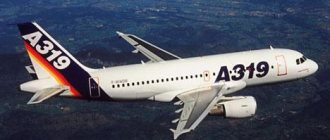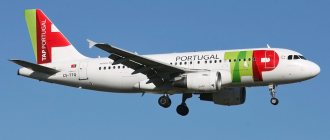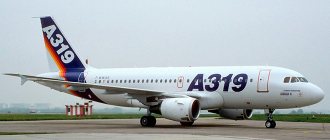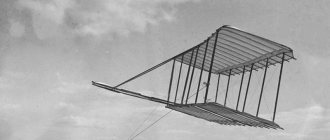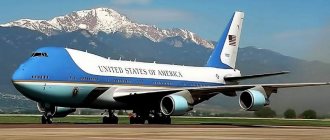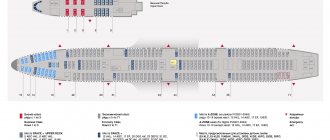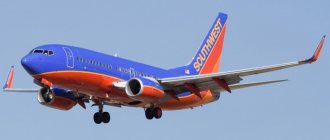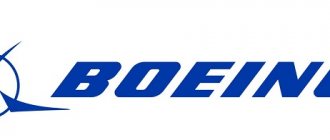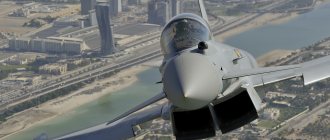Author: Evgeny Zhivoglyadov. Date of publication: July 04, 2016. Category: Articles.
Air travel is the most convenient and only possible way to cross vast distances in a short time. However, traveling by plane is very tiring and it is important to book your hotel in advance and choose the right seat that will best suit your needs. Undoubtedly, air carriers provide passengers with a seat layout, but in order to determine which seats on the plane are best to choose, we recommend that you familiarize yourself with useful information about the most popular models of “air trains” that most often fly from well-known airlines.
The largest carrier in the Russian Federation is, of course, Aeroflot, which has filled the airspace with today’s popular Airbus models 319, 320 and 321. These aircraft differ in modifications, number of seats and their location. Let's look at all the features of each model.
Airbus A320
The Airbus 320 project began to be developed back in 1984, when the Airbus consortium decided to create an “air machine” capable of becoming a competitor to the Boeing 727. In 1987, the first tests were carried out and the new aircraft made its first flight.
The location of seats on the Airbus 320 aircraft and their number differs depending on the modification. Today there are both models for 150 passengers (in business class, the seats are arranged in two rows, with two seats each, and in economy class there is a 3+3 layout), and liners for 180 people with a single-class cabin. There are also intermediate modifications, so the seat layout on the Airbus 320 aircraft will be different. Before purchasing a ticket, be sure to check the model of the specific aircraft on which you are going to travel.
If we talk about the best and worst seats in the Airbus 320, we will take as an example a model for 180 passengers (single-class cabin):
- Seats 1 to 29, A and F. These seats are located next to the window. Since these seats are located far from the aisle, flight attendants and other passengers constantly scurrying around will not disturb you.
- 1 to 29, B and E. The seats are further away from the window, but you can still look out of it. They are also at a distance from the passage.
- 1 to 29, C and D. These seats are next to the aisle, and in addition to this, you will have to let two passengers sitting next to each other through. The only advantages are the ability to stretch your legs into the passage and quick access to the toilet.
- 1 row. If we talk about the advantages of these seats, then first of all it is worth noting that since no one is sitting in front of you, they will not recline the back of their seat towards you. The 1st row has first access to drinks and food, and thanks to a decent distance from the seat to the wall, you can stretch out your stiff legs without difficulty. Another advantage is that you will be the first to leave the aircraft. Among the disadvantages is the discomfort associated with the fact that you will have to look at the wall the entire flight. It is also worth noting that it is in the first row that women with small children most often sit; few people like this proximity.
- Rows 12 and 13. These places are considered the safest, as they are located closest to the emergency exit. These rows also have more space, allowing you to retract your legs. However, very often the seats in these areas do not recline.
- 11 row. The seats are located in front of the emergency exit, which is why they are rarely reclining.
- Row 29/30. The worst places, as they are closest to the toilet and kitchen. Throughout the flight you will “enjoy” the sounds of the tank flushing, slamming doors and other “delights”.
In addition to the Airbus 320, there is also a smaller version of it, the A 319. The plane, diagram, best seats and their features will also be useful.
Airbus A319
The number of seats on an aircraft of this model may also differ depending on the modification. This figure varies from 124 seats (two-class cabin) to 156 seats (single-class cabin). There are dozens of such configurations. To choose the best places, we recommend paying attention to the following nuances:
- From 1 to 5 row. Most often these are business class seats. There is a little more legroom in the first row, and even very tall people can easily cross their legs. The backrests in business class recline more than the rest of the plane. But, just like in the A320, mothers with children most often sit in the first rows; for this purpose, there are even special fasteners for baby bassinets.
- 6th row. It’s almost impossible to stretch your legs in this row, but since there will be a wall in front of you, you won’t have to fear that someone will throw the back of the chair back on you. Food starts to be served from row 6, so from the point of view of access to drinks, this location is the most advantageous. But there are also disadvantages - the tables are built into the armrests, which makes the seats a little narrower.
- 7th row. The seats in this row are located in front of the emergency exit.
- Row 8, A and F. Uncomfortable seats that are slightly “skewed” towards the hatch. However, these seats have more legroom.
- Row 8, B,C and D,E. According to statistics, these are the most comfortable and safest economy class seats. They are located closest to the emergency exit and have plenty of legroom. There are restrictions for these seats; passengers with animals, children, people with disabilities and the elderly are not allowed to sit on the seats.
The worst seats are located in the last 21st row, as well as seats C and D in the 20th row. Here, just like in the A320, you will be closer to the toilet, and you will be the last to receive drinks and food.
The best and worst places
The A319 airliner, being a shortened version of the A320, has 2 fewer rows of seats. But a company engaged in the production of aircraft, if required by the customer, can carry out individual formation of seats.
The aircraft cabin can be represented by three classes: business, first, economy. And 319 can carry 156 passengers. With this option, there will be only 30 centimeters of space between the seats of adjacent rows. This option is usually called the basic economy class configuration. The cabin has 26 rows. There are 6 seats in each row, 3 on one side of the aisle and the same number on the second.
The best seats are those in the first row. There is more legroom for passengers here than where other seats are located in front. Comfort is reduced by the front blank wall blocking the view.
One of the disadvantages is that there is a toilet and kitchen right behind the partition. Sometimes it happens that a queue forms in the aisle, which somewhat disturbs the passengers sitting there. As for the proximity of the kitchen, although flight attendants appear here more often, when they distribute food, they are the first to receive it here.
The best seats include those in the row next to the emergency exits. There is even more legroom for passengers. True, there are also inconveniences. The armrests cannot be removed there, since folding tables are built into them.
In rows two to ten there are places that differ neither for the better nor for the worse. True, there is a minus in the tenth row. The backs of the seats located here do not recline. This is done so that they do not interfere with passengers leaving the plane through the emergency exit.
To some extent, the comfort of passengers sitting near the aisle in these rows reduces the movement of flight attendants and passengers. Although the passage meets the requirements, people passing here still slightly disturb those in the chairs.
Airbus A319 interior
For the eleventh row seats, located near the emergency exit and recognized as the best, there are restrictions on the sale of tickets. Places here are not provided for children, disabled people, or pregnant women. Such seats are not sold to passengers traveling with animals, as well as to foreigners if they do not know Russian or English, or even simply understand them poorly.
In the middle and rear sections of the cabin there are seats that fall into the standard category. Of course, even in them, those who sit next to the aisle sometimes find themselves in somewhat cramped conditions due to the passengers moving around here.
Airbus A319 passenger seat layout
Aircraft design
The entire line of Airbuses of this modification has the same design. This is a low-wing aircraft, that is, the wing is located at the bottom of the fuselage. The fuselage itself is narrow, the tail is vertical, single-finned.
The power unit consists of two turbofan engines, their brand varies depending on the model.
The chassis has three legs, two in the middle of the body, one in front. Due to the use of composite materials and low weight, the aircraft picks up speed faster than similar competitors. The design of the cockpit is interesting.
Instead of a traditional steering wheel, there are side sticks, or otherwise side control sticks. The slightest movement - the command of one of the two pilots is read by the computer and instantly gives the necessary command to one or another plane.
The passenger compartment is divided into two unequal parts. The smaller one, five rows deep, has two seats on the left and right sides, for a total of four, business class. This is an area of increased comfort, but also of increased ticket prices. Business class seats, usually with leather upholstery, allow you to endure a long flight without harm to your body.
The distance between the seats makes it possible to unfold the chair for rest or sleep without discomfort for the other passengers. The food, accordingly, is also of a higher class. The traveler also needs to remember that the first row is located next to the toilet and technical area.
Lines to get to the bathroom, as well as constant hassles from staff, can make traveling cumbersome. It is also important that the lights are constantly on in this area, which means that it is unlikely that anyone will be able to get enough sleep and rest.
Most of the cabin, from the sixth to the twenty-first row, is economy class.
There are some tricks here too. The sixth and seventh rows are considered “conditionally elite” on the plane. Their relative comfort is much higher due to the large space and proximity to business class. The relative comfort of these places is due to the fact that they are usually reserved for mothers with infants.
Accordingly, certain difficulties may arise during the flight, because not everyone will be able to coexist with a child who is worried about the flight. The seats in economy class are already three deep on each side. The four inner seats in the eighth row are considered the most comfortable among passengers. This row is conveniently located next to the emergency passages, allowing passengers to sit more comfortably.
True, the chairs near the building itself are awkwardly turned and are very much for everyone. The ninth row is considered the most inconvenient for passengers. However, there are a number of modifications, depending on which these series are considered either worse or better.
To order tickets, you need to take into account the individual psychological characteristics of the passenger. Thus, restless people do not need to take window seats, since exiting would require disturbing two passengers closer to the center. For people with a creative mindset, these are the best places, as they are located near the window. The middle seats lack one armrest. The seats at the edge of the cabin will be inconvenient for those who want to rest and sleep.
Activity
This company has its factories in four European countries, and each of them produces specific parts, and the final assembly of aircraft is carried out in France and Germany, namely in the cities of Toulouse and Hamburg. Due to the very large volume of work and the large number of factories, this corporation has a huge staff of employees, namely about 50 thousand people. As for the scale of production, it is very large. Thus, in 2006, 824 airliners of various designs were ordered from this company. All this cost customers $75 billion.
The following year, the number of vehicles ordered increased to 1,341 units. And these production rates are increasing every year. The first airliner was put into operation only in 1974. Over the entire period of its existence, the company has manufactured more than 6.3 thousand aircraft for various purposes and modifications for its customers. At the moment there is a very large order of 390 billion euros. And this suggests that in the coming years, even in the absence of other orders, there will be something to work on.
In previous years of operation, this company seemed to be in the shadow of a powerful competitor, which is the Boeing Corporation. But in the last decade, this trend has changed in favor of Airbus. At the moment, it is rightfully considered Boeing’s main competitor, since the European company has even surpassed the Americans in some areas of activity. The latest and most advanced Airbus aircraft was the A320 type aircraft. It was he who was able to bring the corporation to a qualitatively new level in this sector of the world economy.
basic information
The aircraft was developed by Airbus Industry. The prototype for the development of the A319 was the model of the Airbus A320. The new model is shortened, it has only 120 seats for passengers. During development, the aircraft received the designation A320M-7. This was later assigned to A319.
The first tests of the aircraft dated back to 1990, but official development began in 1992. The first copy of the A319 was built in 1995, and in the same year it took off for the first time. In 1996, the aircraft received the appropriate flight certificate. The first Airbus model A319 was purchased by a Swiss company.
Only 2,000 aircraft of this type were produced. The cost of one copy is 86 million dollars.
Now the aircraft is operated by most of the world's leading air carriers. Airbuses became part of Aeroflot in 2003. That same year, Airbus signed an agreement that the production of some elements of the A319 would be carried out in Russia (Irkutsk and Nizhny Novgorod).
Video of Airbus A319 takeoff:Products
This company has recently been actively developing the production of 320 series aircraft, and new special modifications are being developed based on them. The founder of all new aircraft was the A320 type model. It is a twin-engine vehicle with a central passage that leads to the cockpit. There are 4 entrances for boarding passengers and 4 additional exits in an emergency. The airliner can accommodate 180 passengers in two classes.
The second most popular is the A319 passenger airliner. It differs from the previous version in having a shortened fuselage, due to which it can carry fewer passengers. The A319 began to be used for various transport operations in 1999. This machine can easily fly at various distances and have different interior configurations. For very long-distance flights, a modification of the A319 CJ was developed. A modification of the A319LR has been manufactured for VIP flights. It is designed to carry 39 passengers in a comfortable cabin, but at the same time has a long flight range of 12 thousand kilometers.
The largest vessel of this class can be called the A321 model. It can accommodate 220 people on board, who are accommodated in one cabin. Devices with two classes are possible, in which 185 passenger seats are installed. With all this, the maximum flight range is 5.6 thousand kilometers.
In 2003, the Airbus A318 aircraft entered service. It can accommodate a maximum of 132 passengers and transport them over a distance of 5.75 thousand kilometers. A special feature of the machine is that it can take off and land on runways that are fairly short in length, and land on a fairly steep approach path. It is not as noisy as other models. All this allows it to be used at airfields in large cities, where there are many buildings. The A318 also has newer and more accurate avionics than its predecessors. These figures have significantly reduced maintenance costs.
The latest and smallest development is a device called A318 Elite. In addition to its small size, it has a low price. At the moment, the European aircraft manufacturing company is working on creating more reliable and economical aircraft, and continuous improvement of already created devices is underway.
The Airbus Corporation operates in many countries around the world, and airplanes can be found in all corners of our planet. Even a Russian company called PSMPO-Avisma cooperates with Airbus, namely, supplies titanium. It also has a contract for the supply of aluminum and its alloys.
In Russia, an Airbus branch was opened in 2003, which cooperates with the ECAR engineering community. Irkut Corporation also manufactures individual components for European airliners. The Voronezh Aircraft Manufacturing Plant also produces components. In terms of partnerships, the biggest achievement was the combination of , Airbus and EFW to carry out the modification and improvement of passenger aircraft such as the A320. But these partnerships were terminated in 2010 due to financial problems.
Accidents and disasters
As of January 10, 2022, a total of 44 aircraft of the Airbus 318/319/320/321 family were lost as a result of accidents and serious accidents. Airbus 318/319/320/321 was attempted to be hijacked 16 times, with 1 person killed. A total of 1,393 people died in these incidents.
The largest fatality accident in the history of the A320 family occurred on October 31, 2015, killing 224 people.
| date | Board number | Place | Victims | Description of the incident |
| 26.06.1988 | F-GFKC | Absem | 3/136 | Demonstration flight. It crashed into a forest because the spectators were positioned in the wrong direction and the pilots directed the plane not to a long field, but to a forest. |
| 14.02.1990 | VT-EPN | Bangalore | 92/146 | Crashed during landing due to pilot errors. |
| 20.01.1992 | F-GGED | Strasbourg | 87/96 | Crashed while descending. The crew incorrectly set the autopilot parameters. |
| 14.09.1993 | D-AIPN | Warsaw | 2/70 | During landing, it skidded off the runway due to crew errors. |
| 10.03.1997 | A4O-EM | Abu Dhabi | 0/115 | Aborted takeoff. |
| 22.03.1998 | RP-C3222 | Bacolod | 3+0/130 | During landing, the pilots forgot to put one engine in reverse. |
| 11.04.2000 | F-OHMD | Minatitlan | 0/0 | Burnt out while refueling. |
| 23.08.2000 | A4O-EK | Muharraq | 143/143 | Crashed into the sea during the go-around due to crew errors. |
| 07.02.2001 | EC-HKJ | Bilbao | 0/143 | Rough landing. |
| 24.07.2001 | 4R-ABA | Colombo | n.d. | Tamil Tigers attack on the airport. |
| 28.08.2002 | N635AW | Phoenix | 0/159 | Rough landing. |
| 19.01.2003 | N313NB | NY | 0/2 | Crashed into a wall while moving to the terminal due to a technician error. |
| 21.03.2003 | B-22603 | Tainan | 0/175 | Rough landing. |
| 03.05.2006 | EK-32009 | Sochi | 113/113 | Fell into the water during go-around due to crew errors. |
| 05.05.2006 | EK-32001 | Brussels | 0/0 | Burnt out in the hangar. |
| 05.05.2006 | EK-32010 | Brussels | 0/0 | Burnt out in the hangar. |
| 05.05.2006 | SX-BVB | Brussels | 0/0 | Burnt out in the hangar. |
| 18.07.2007 | PR-MBK | Sao Paulo | 12+187/187 | During landing, he left the runway and crashed into a fuel and lubricants warehouse. |
| 26.10.2007 | RP-C3224 | Butuan | 0/154 | It rolled off the runway and crashed into trees. |
| 30.05.2008 | EI-TAF | Tegucigalpa | 2/124 | It rolled off the runway and broke into pieces. |
| 27.11.2008 | D-AXLA | Perpignan | 7/7 | Test flight. Icing of stall system sensors. |
| 15.01.2009 | N106US | Hudson | 0/155 | Birds got into the engines. Emergency landing on water. |
| 28.07.2010 | AP-BJB | Islamabad | 152/152 | During landing in difficult weather conditions, I crashed into a mountain. |
| 24.09.2010 | EI-EDM | Palermo | 0/129 | Rough landing to the end of the runway. Decommissioned. |
| 25.08.2011 | 5A-ONK | Tripoli | 0/0 | Damaged during fighting at the airport, burned down during new clashes in 2014. |
| 05.05.2012 | JA8384 | Sendai | 0/108 | The tail hit the runway during a missed approach. Decommissioned. |
| 06.02.2013 | TS-IMB | Tunisia-Carthage | 0/83 | Landing with the front pillar retracted. Decommissioned. |
| 16.03.2013 | N620SC | Jakarta | 0/0 | Damaged in a parking lot during a thunderstorm. |
| 03.07.2013 | JY-PTA | Tripoli | 0/1 | Fire in the cockpit (an oxygen tank exploded during maintenance). |
| 05.01.2014 | VT-ESH | Jaipur | 0/179 | Landing away from the runway in difficult weather conditions. |
| 14.04.2014 | XY-AGT | Yangon | 0/n.d. | While being towed, it collided with another aircraft on the apron. |
| 27.07.2014 | 5A-LAI | Tripoli | 0/0 | The tail section was destroyed during artillery shelling of the airport. |
| 28.12.2014 | PK-AXC | Java Sea | 162/162 | Fell into the water due to problems with the on-board computer and erroneous actions of the crew to eliminate them. |
| 24.03.2015 | D-AIPX | Alps | 150/150 | The co-pilot deliberately directed the plane into a mountain range. |
| 29.03.2015 | C-FTJP | Halifax | 0/137 | Rough landing to the end of the runway, the wing caught a power line. |
| 14.04.2015 | HL7762 | Hiroshima | 0/82 | During landing, I hit the radar antenna and left the runway. Decommissioned. |
| 25.04.2015 | TC-JPE | Istanbul | 0/97 | Engine fire. After an emergency landing, he left the runway, turning 180°. |
| 31.10.2015 | EI-ETJ | Sinai peninsula | 224/224 | Blown up by terrorists. |
| 02.02.2016 | SX-BHS | Mogadishu | 1/81 | Attempted explosion, made an emergency landing. Decommissioned. |
| 19.05.2016 | SU-GCC | Mediterranean Sea | 66/66 | Fire with loss of control. Egyptian authorities believe there was an explosion on board. |
| 08.12.2017 | A7-AIB | Doha | 0/n.d. | Fire in the parking lot during maintenance. |
| 15.01.2018 | 5A-ONC | Tripoli | 0/0 | Damaged by shelling during fighting near the airport. |
| 28.02.2018 | ES-SAN | Tallinn | 0/7 | Training flight. Landed in the snow before the end of the runway due to loss of control. |
| 15.08.2019 | VQ-BOZ | Zhukovsky | 0/233 | After takeoff, birds got into the engines. Made an emergency landing in a corn field. |
| 10.01.2020 | VQ-BRS | Antalya | 0/n.d. | The flight was without passengers, the crew was not injured. Emergency landing with significant overload, significant damage to elements of the nose landing gear and the front lower part of the fuselage. |
Analog aircraft
The main competitors for the A320 family are aircraft from the Bombardier CS 300 and . The Boeing 757 competes with the A321 with a slightly longer range and slightly larger passenger capacity, but was discontinued in 2005. For the A318 and A319 models, rival models may be legacy variants such as the discontinued Boeing 717.
The Soviet Tu-154 aircraft, having similar parameters, spends more kerosene on transporting each passenger, even in the latest modification of the Tu-154 M
, and therefore cannot withstand commercial competition. The newer Tupolev model - 204/214 - is generally comparable to the A321 in terms of commercial efficiency, but was produced in small quantities (less than a hundred cars) and has now actually been discontinued, so it also cannot be considered as a serious competitor.
Comparative characteristics with competitors
The main opponents of Airbuses in the battle for airspace are Boeings and Canadian Bombers. In the 1990s and 2000s, the Tu-154 and the modernized version of the Tu-204/214 tried to compete with these aircraft, but higher fuel consumption, non-compliance of domestic aircraft engines with environmental safety requirements in the West and production problems removed this competitor from the distance.
At this stage, the brainchild of the Sukhoi Design Bureau SU Superjet and the projected Irkut are joining the fight. How the competition with Russian aircraft will turn out remains to be seen.
Foreign companies do not stop trying to knock the reliable Airbus out of the air transportation market, or at least reduce its share.
The characteristics of the aircraft are approximately equal. If there is a difference between the number of passenger seats and the flight range, it is compensated by higher fuel costs. A new proposal can be made by the Canadian Bombardier, who announced the development of systems that reduce kerosene consumption by 20%.
Airbus A319 models and modifications
Unlike the A320 modification, the Airbus A319 has a smaller fuselage. It also reduces the number of passenger seats by reducing the number of rows in the cabin. The model is characterized by an increased flight range and different capacity, depending on the cabin layout. These are the main advantages of the A319 aircraft.
Basic versions: Airbus A319-110 and A319-130. A unique version is the A319-LR with an increased flight range of up to 8,300 km due to additional fuel tanks equipped with the aircraft.
Another model with an increased flight range is the Airbus A319-CJ.
The manufacturing company also produces custom-made business aircraft - the Airbus Corporate Jet with a high-comfort cabin for 39 passengers. This ship has a room for business meetings, a shower room, a small gym and a cozy lounge with multifunctional lounge chairs. The maximum flight range is 12,000 km.
S7 Airlines
On S7 airline flights, Airbus A319 aircraft have 144 seats. The layout is simple, without business class, single cabin - only economy class seats.
The best seats on the A319 are not marked for the S7, since the company does not allocate luxury seats. However, some chairs still have advantages due to their location. Thus, unofficially, passengers recognize the best seats as the seats in the 11th row near the emergency exits: their only (but also important) feature is the increased distance to the row in front, as a result, sitting is much more comfortable in the sense that you can freely stretch your legs and passengers in front do not will cause inconvenience with a lowered backrest.
Tickets to the front of the cabin (rows 1–3) are also considered successful: in this case, you will be among the first to be served food on board, you have the opportunity to leave the plane faster upon landing (no need to stand in line behind passengers who take a long time to collect their belongings), and this moment is already especially relevant for those flying with a short layover.
The worst seats are at the back of the cabin. And they have several disadvantages: these are seats near the toilets, there is less space for hand luggage on the shelf, the backs of the seats are blocked, it takes a long time to get in and out.
s7.ru
The most successful line of 320 airliners
This family of aircraft is a new narrow-body airliner that is designed for short and medium distance flights. The very first car of this class was created in early 1988. By mid-2010, more than 4.5 thousand of these devices were delivered to customers. In addition, there was also an order for 6.5 thousand of these aircraft. Of all the manufactured airliners, more than 4 thousand are currently in operation.
Despite very good sales and order figures, Airbus still remains in second place in this market. The first place is occupied by the Boeing Corporation.
The further path of the airliner
In the time that has passed since the first flight of the A319, its developers have continued to improve the aircraft. To date, there are four modifications of it. They concern not only the installation of additional fuel tanks, which allows you to cover much longer distances, but also the installation of more advanced engines.
Of course, when a plane flies more kilometers on one refueling, that’s good. But it should be remembered that this option carries much less passengers than the models used on passenger airlines. After all, there is constant competition here. It is necessary to transport more people, over longer distances, at lower costs, and therefore cheaper.
Of course, the development of more advanced models continues. However, as always happens, they are kept secret. This is necessary in order to, when everything is ready, offer a new, more advanced model to airlines, thereby squeezing out competitors.
Taxi cost calculation to the airport
Useful links for tourists
Airbus in the sky
The aircraft model in question is used on major airlines around the world. Medium and short distance communications capable of covering Europe, America, and Asia are extremely popular. First of all, due to its low cost. The only drawback seriously considered by people knowledgeable in aircraft technology is the computer system on board.
The first accident of Airbuses of this line, in 1987, occurred due to a failure in this system. But you can be sure that since then the equipment has been adjusted, and aviators and insurers note the high reliability of the device. Over the years of use, 37 aircraft were lost. Most of them became a victim of the human factor, or were lost due to wars or terrorist attacks.
Over the more than thirty-year history of this aircraft, several upgrades have been made:
- A318, a machine introduced into service in 2003, with improved electronics and a lower noise threshold, making it possible to use the aircraft within urban areas;
- A319, a shortened model of the basic “three hundred and twentieth”, with the ability to replace part of the seats with additional fuel tanks, which significantly increases the range;
- A320, the founder of the line, about which most of this article is presented;
- A321, members of the family changed to increase in size.
As for the A319 specifically, it also has several models:
- A319-LR;
- A319-110;
- A319-130;
- A319-ACJ.
The 110 and 130 models differ only in the CFM56 and AeroEngines V2500 engines, respectively. The A319-LR is the most successful model; it is the one that is most in demand on the transportation market due to its flight range increased to 8 thousand km. ACJ aircraft for VIPs with a capacity of 10...40 passengers.
Shower cabin, gym and other frills with an increased range of up to 12 thousand km. give the model additional popularity in the private jet market.
The presented modifications occupy a worthy place in air transportation around the world. Of course, competition continues to operate, but European aircraft, known for their reliability and comfort, are in great demand for transportation.
The prospects for the type of aircraft under consideration are extremely tempting.
Continuing work on the creation of new models based on the Airbus A319, and other machines in the series, is bearing new fruit. In conditions of crises and an unstable fuel market, Airbuses are in great demand among managers and private owners. Passengers trust these cars because of their high degree of reliability and low accident rate.
Features of Airbus aircraft production
As mentioned, many factories in Europe simultaneously manufacture parts. The final assembly of the finished aircraft was carried out only in the city of Toulouse, but since 2008, due to the great demand for these airliners, assembly had to be launched in the city of Hamburg. In order to increase the speed of production, it was decided in 2011 to begin building aircraft in China. This enterprise has a sufficiently powerful base that allows it to produce 4 aircraft every month.
The plant in Hamburg is currently considered the most powerful and advanced in production. It is located near the Elbe River, where there is a huge area with assembly hangars and buildings for engineers and designers. To ensure high-quality and successful work, this plant has 19 thousand employees.
The main components are manufactured by a separate country. Thus, the tail section of the cars is produced in Hamburg or Bremen, the bow section is manufactured by Spanish designers. Case components are produced simultaneously by France and Germany. And the UK produces wings for aircraft.
In order to transport parts for aircraft to the plant where they are assembled, the corporation does not use the railway, as other airlines do, but transport aircraft of its own production, namely the Airbus A300, or, as it is also called, Beluga. A total of 4 such devices have been created, which make several flights daily to transport parts between factories. This multifunctional machine can perform many tasks.
Making an airplane
The birth of new modernized types of Airbus aircraft occurred at the end of the 1980s. Competition with Boeing and the Canadian Bomber led to the release of the Airbus A320, with the first installed remote control system for electric drives. The 1990s were marked by constant work to modernize the base model. One of the most popular developments is the Airbus 319 model. In 1995, the A319 took off for the first time, and the very next year it received the certificate necessary for operation.
The modernizations were designed to improve passenger capacity and improve economy while maintaining the size of the main model. The work on the project gave an acceptable result, and as a result, the closest competitors were pushed aside. The initial model is designed for medium-distance passenger transportation. Demand forced engineers to create models that differed from the base car.
At the moment, modifications of the A320 and A319 are extremely common.
The difference in the models is only in length (A319 is 4 meters shorter). But the A319 has a longer flight range. The popularity of this particular model is evidenced by the fact that orders were placed with the company for more than 10 thousand aircraft. This is with 8 thousand cars already produced. Since 2003, the Russian air transportation market has been open to Airbuses.
Until 2008, the design was produced in Toulouse, France. Orders were then placed for production in Hamburg. The reason for the expansion is the high demand for the aircraft in global aviation. China has also made efforts to obtain orders for this aircraft. Some parts are also created in Russia, in Irkutsk.
Assembling aircraft in Europe has certain disadvantages. The biggest thing is that planes are sold in dollars, while European workers receive euros. Due to the low dollar exchange rate, this causes painful blows to the company's finances.
Literature
- Aris, Stephen.
Close to the Sun (undefined). - London, UK: Aurum Press Ltd, 2002. - ISBN 978-1-85410-830-2. - Eden, Paul E. (general editor).
Civil Aircraft Today (unspecified). - London: Amber Books, 2008, 2008. - ISBN 978-1-905704-86-6. - Gunston, Bill.
Airbus: The Complete Story (undefined). - Sparkford, Yeovil, Somerset, UK: Haynes Publishing (English) Russian, 2009. - ISBN 978-1-84425-585-6. - Norris, Guy and Mark Wagner.
Airbus (undefined). — St. Paul, Minnesota: MBI Publishing (English) Russian, 1999. - ISBN 978-0-7603-0677-2. - Reed, Arthur.
Airbus: Europe's High Flyer (undefined). - Zürich, Switzerland: Norden Publishing House, 1992. - ISBN 978-3-907150-10-8.
Production
Airbus A319 cockpit
A320 main landing gear
Until February 2008, the A320 was assembled only in Toulouse, but from March 2008, due to high demand, assembly was also deployed at the Hamburg-Finkenwerder plant. All other versions of the A320 family were and are produced in Hamburg-Finkenwerder. In addition, an assembly line for A320 family aircraft was opened in China with an estimated productivity of four aircraft per month (in 2011).
Components from various Airbus factories are transported for final assembly to Hamburg (A318, A319, A321) and Toulouse (A320). Almost all transportation is carried out on the A300-600ST Beluga aircraft.
During the economic recovery of the Airbus concern in 2007, German managers managed to achieve the transfer of A320 production from France to Germany. It is planned to increase the number of aircraft produced to 42 per month from the 4th quarter of 2012.
In addition, the production of A320 airliners has been established in the People's Republic of China. It was planned since 2010 that the concern’s Chinese factories would produce up to fifty aircraft per year. Also, the Irkutsk Aviation Plant in Russia produces components for A320 type airliners.
The A320 helps Airbus Industry compensate for losses associated with problems in the production of the giant A380 aircraft. The order portfolio is formed by Asian airlines and leasing companies.
The biggest problem for Airbus SAS remains the low dollar exchange rate. Payment for aircraft is made in dollars, while most production is located in the eurozone.
Since 2014, Airbus began production of the new generation A320 neo. The first aircraft was put into operation in 2016.
Where is the best place to sit on an airliner?
Many airlines allow passengers to pre-book the best seats in the cabin for a fee or free of charge, depending on the fare chosen and the carrier's conditions.
What are the best seats to occupy on the Airbus A319:
- On an airplane with a capacity of 128 people, the most comfortable seats are in business class, occupying rows 1-2 (8 seats). In economy class, seats of increased comfort with expanded legroom are located in rows 3 and 9. The most uncomfortable seats on the plane: row 8 with the backrest lowering mechanism blocked and row 22, behind which there is a toilet. Rows 20-22 are equipped for passengers with disabilities.
- The A319 for 150 people has a single-class cabin layout - economy. The most comfortable seats are on rows 1, 10 and 11. Inconvenient for location - rows 9 and 25 with limited seat backrest tilt.
- The cabin has 116 seats and two classes of service. Comfortable seats are in business class, occupying the first five rows. Seats with a wide pitch between the seat and the partition are located in the 6th row of economy class. On the 7th row, the seat back does not recline, so these seats are considered the most uncomfortable for a flight. Also, do not occupy the last 21 row of economy, behind which the toilet room is located.
- The Airbus has only one class of service for 144 seats - economy. Comfortable seats in the cabin with increased space - rows 1, 11, 12. Seats with a locked folding mechanism are located near the emergency exit and in the last 24th row of the cabin. There is also a toilet behind it, so there are often queues of passengers here.
Before choosing a seat on an Airbus A319 for a comfortable flight to your chosen destination, be sure to study the layout of the aircraft for which you purchased the ticket!
Airbus A321
The A321 model is the largest aircraft of the A320 family; in fact, it is an extended version of it, which is characterized by high capacity. This “air train” has a standard configuration that includes a two-class cabin. The number of passengers is 169 economy class seats and 16 business class seats.
However, you can also find other configurations of the A 321. The aircraft, layout, and best seats may differ depending on the flight range. For example, for charter flights, a modification is made to increase the number of seats to 220 in economy class. To determine which seats are better on an airplane of this model, let’s look at a standard Airbus from Aeroflot.
- From 1 to 7 row. These are business class seats, however, compared to previous models, they are uncomfortable. In front of the 1st row there is a wall separating the toilet, which does not particularly protect against unwanted sounds. Sitting in row 7, you will hear the noisy economy class. Therefore, when traveling in first class, try to choose a seat located from rows 2 to 6.
- 8 row. Drinks are served in economy class from this row. In addition, there is more legroom.
- 18th row. By and large, this row contains standard seats, however, they are located in close proximity to the toilet.
- 19 row. These are seats located behind the emergency exit, so in this row, like in row 8, there is free space. Of the minuses, restrooms, the visitors of which will cause inconvenience.
- 20 row. Very comfortable and good places. Although there is no additional legroom in this area, in row 20 the seats are located close to the windows.
The seats in the penultimate and last row (row 30, C and D, as well as row 31), as in the first two cases, are among the most uncomfortable, due to their close location to the restrooms. It is recommended to choose such seats only in a desperate situation.
